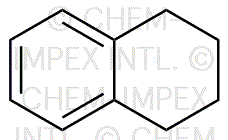1,2,3,4-Tetrahydronaphthalene is widely utilized in research focused on:
- Solvent Applications: This compound serves as an effective solvent in organic synthesis, allowing researchers to dissolve various organic compounds without interfering with reactions.
- Polymer Production: It is used as a monomer in the production of certain polymers, enhancing material properties such as flexibility and durability in industries like plastics and coatings.
- Fragrance Industry: Due to its pleasant odor, it is incorporated into perfumes and fragrances, providing a unique scent profile that appeals to consumers.
- Fuel Additives: It acts as a component in fuel formulations, improving combustion efficiency and reducing emissions, which is crucial for the automotive industry.
- Research in Organic Chemistry: The compound is frequently utilized in laboratories for studying reaction mechanisms and developing new synthetic pathways, aiding in the advancement of chemical knowledge.
General Information
Properties
Safety and Regulations
Applications
1,2,3,4-Tetrahydronaphthalene is widely utilized in research focused on:
- Solvent Applications: This compound serves as an effective solvent in organic synthesis, allowing researchers to dissolve various organic compounds without interfering with reactions.
- Polymer Production: It is used as a monomer in the production of certain polymers, enhancing material properties such as flexibility and durability in industries like plastics and coatings.
- Fragrance Industry: Due to its pleasant odor, it is incorporated into perfumes and fragrances, providing a unique scent profile that appeals to consumers.
- Fuel Additives: It acts as a component in fuel formulations, improving combustion efficiency and reducing emissions, which is crucial for the automotive industry.
- Research in Organic Chemistry: The compound is frequently utilized in laboratories for studying reaction mechanisms and developing new synthetic pathways, aiding in the advancement of chemical knowledge.
Documents
Safety Data Sheets (SDS)
The SDS provides comprehensive safety information on handling, storage, and disposal of the product.
Product Specification (PS)
The PS provides a comprehensive breakdown of the product’s properties, including chemical composition, physical state, purity, and storage requirements. It also details acceptable quality ranges and the product's intended applications.
Certificates of Analysis (COA)
Search for Certificates of Analysis (COA) by entering the products Lot Number. Lot and Batch Numbers can be found on a product’s label following the words ‘Lot’ or ‘Batch’.
*Catalog Number
*Lot Number
Certificates Of Origin (COO)
This COO confirms the country where the product was manufactured, and also details the materials and components used in it and whether it is derived from natural, synthetic, or other specific sources. This certificate may be required for customs, trade, and regulatory compliance.
*Catalog Number
*Lot Number
Safety Data Sheets (SDS)
The SDS provides comprehensive safety information on handling, storage, and disposal of the product.
DownloadProduct Specification (PS)
The PS provides a comprehensive breakdown of the product’s properties, including chemical composition, physical state, purity, and storage requirements. It also details acceptable quality ranges and the product's intended applications.
DownloadCertificates of Analysis (COA)
Search for Certificates of Analysis (COA) by entering the products Lot Number. Lot and Batch Numbers can be found on a product’s label following the words ‘Lot’ or ‘Batch’.
*Catalog Number
*Lot Number
Certificates Of Origin (COO)
This COO confirms the country where the product was manufactured, and also details the materials and components used in it and whether it is derived from natural, synthetic, or other specific sources. This certificate may be required for customs, trade, and regulatory compliance.


